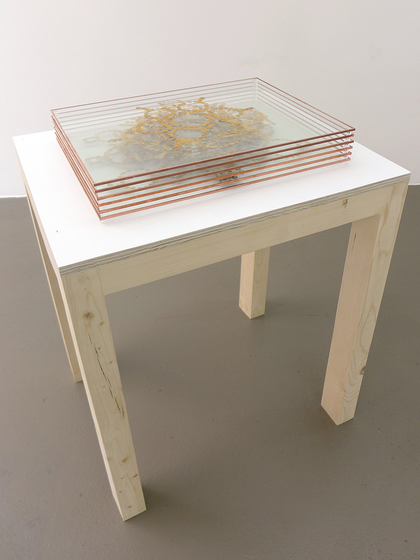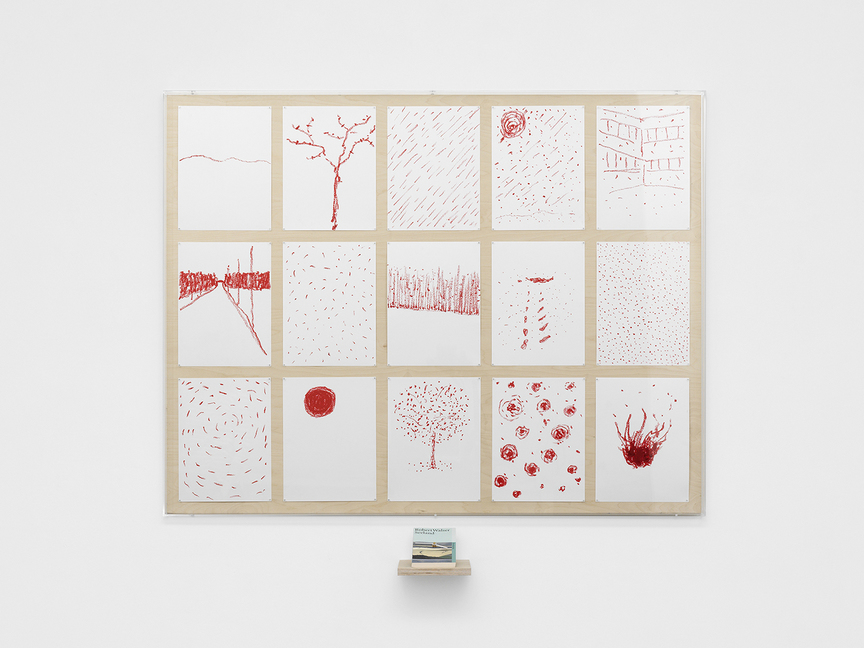-
From Current Issue
-
- Editor’s Letter Fire in the Heart
- Reviews I Gusti Ayu Kadek Murniasih
- Reviews 11th Seoul Mediacity Biennale: “One Escape at a Time”
- Dispatch Networked China
- One on One Monira Al Qadiri on Yukio Mishima
- Essays The rise of independent art spaces in pandemic-era Shanghai
- Features Tuan Andrew Nguyen
- Table of Contents
- Web Exclusives
- Archive
- Subscribe

R
E
V N
E
X
T
Installation view of SARKIS’s “Punctum” at Galerie Mezzanin, Geneva, 2018. Photo Annik Wetter. All images courtesy the artist and Galerie Mezzanin, Geneva.
In “Punctum”—a reference to Roland Barthes’s notion of “an unexpected mark” in a photograph that holds the spectator’s gaze, expounded in his 1980 book Camera Lucida—Paris-based, Turkish-Armenian artist Sarkis reflects on his relationship to Switzerland. Just down the road from Geneva’s Museum of Modern and Contemporary Art, where Sarkis has a permanent exhibition space, Galerie Mezzanin was transformed into a temporary studio space for the artist, in which, over several weeks, he created a series of new works (all 2018) that bring back memories of the past, involving his previous shows and the people who influenced his career, with a special tribute to Swiss writer Robert Walser.
Upon entering the gallery space, visitors encountered the desk that Sarkis used in developing the show. Tubes of paint were aligned on the table, beside a potted flower, representing a permanent symbol of life that animates the show. A sound installation punctuated the visit, in the form of tolling church bells that suggest the passage of time and a sense of sacredness. The show guided the visitor in a walk down memory lane, perhaps in reference to Walser’s seminal novella, The Walk (1917).
In the main room, four wooden tables support metal structures that open like books to reveal 15 black-and-white pictures each, taken from Sarkis’s personal archives and with interventions applied on the surface of each print, from squares of gold leaf to finger-paint prints on rolling paper. 15 expositions en Suisse depuis 1969 (“15 Exhibitions in Switzerland Since 1969”) comprises a chronological series of installation photographs from the artist’s Swiss shows, marked by paper rectangles featuring painted yellow forms that float on the surface. Meanwhile, in Les Proches (“Close Ones”), the focus is on people who have inspired Sarkis’s career: red finger prints on rolling paper punctuate the space above the seated picture of Joseph Beuys’s young daughter, for example, while iridescent finger paint is used to mark the heart area in a portrait of Soviet-Armenian filmmaker Sergei Parajanov. The minimalist collage elements seem to revive the archival photographs, bringing them back into present time, while marking Sarkis’s relationship to the past.
Between these metal books of photographs were two more tables, layered glass installations, including one titled 6 vitraux d’après des plans des églises et monastères arméniens (“6 Stained Glass Windows Based on the Plans of Armenian Churches and Monasteries”). Here, Sarkis works again with architectural blueprints and stained-glass formats, using thumbprints of gold paint to outline plans that are superimposed atop one another, giving depth to two-dimensional representations. The use of thumbprints on glass has been explored in other exhibitions, such as “Respiro,” Sarkis’s contribution to the Turkish Pavilion at the 2015 Venice Biennale.
Also on view was Sarkis’s new “Book Clock” series, paperback books—four by Robert Walser, one by WG Sebald—that include a working clock mechanism on their covers, synchronized to tell the actual time at the location. In the second room, a book-clock of Walser’s Seeland is displayed on a small wooden platform; unlike the other books, the second hand is absent—perhaps to convey a comparative stillness. Directly above, presented in three rows of five, were 15 drawings rendered in red lipstick, a medium Sarkis has used before. The renderings depict different elements of landscape: a bright red sun on a white page, for example, or a budding tree. The outlier recreates a photograph of Walser’s corpse, after he died of a heart attack during a walk: a series of red marks indicate steps in the snow, leading to the horizontal red form of the writer’s collapsed body.
“Punctum” reflected on the past, on the passage of time and its impermanence, and was the first time the artist has reflected on his relationship to a country. It was uplifting and hopeful: time marches forward, but beauty and life are constant. The show was more than a collection of new works, but an experience in its entirety, and one that seems to be infused with Sarkis’s presence.
Sarkis’s “Punctum” is on view at Galerie Mezzanin, Geneva, until June 30, 2018.
To read more of ArtAsiaPacific’s articles, visit our Digital Library.






